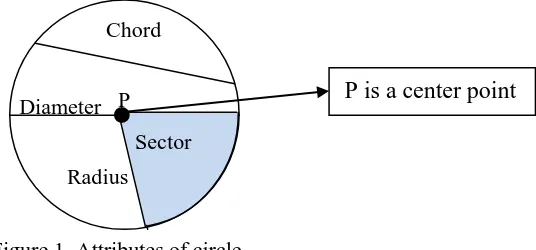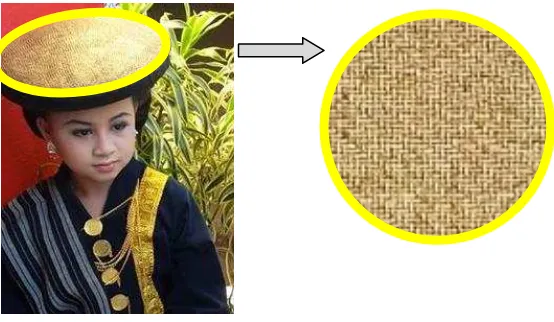E
–
12
Caping Kalo As Kudus Cultural Heritage To Construct Circle Concept
Of Primary School Students
Eka Zuliana, M.Pd
Department of Primary School Teacher Education, Muria Kudus University, Central Java, Indonesia
Abstract
There are some problems in mathematics education at SD 1 Kaliputu especially in geometry. At the learning process, circle concepts given by teacher orally. Use of learning resources also not optimal, realistic problems that exist in the surrounding environment is not use. As the impact students just memorize by recitation, not construct concept alone, so that conceptual understanding of students very low and meaningful learning can not happen. The aim of this research is to find how can students construct circle concept by using caping kalo as kudus cultural heritage and make meaningful learning.
The research was conducted at fifth grade of SD 1 Kaliputu. Data were collected using observation, documentation and test. The result of this research showed that caping kalo as kudus cultural heritage can construct circle concept of the students and make meaningful learning.
Keyword: Caping Kalo, Kudus Cultural Heritage, Circle Concept
Introduction
Today cultural heritage is marginalized. Cultural heritage values if not maintained properly. Feared to be eroded due to the rapid development of information technology that can be easily and instantly accessible by anyone even for children at elementary school. Children who should be a lot of learning and development activities in accordance with his age.
Based on classroom observation conducted by researcher on mathematics subject, this case also happened at SD 1 Kaliputu. Elementary school students who should be at concrete operational stage not given the appropiate learning process. At geometry learning process, for example at circle material they just memorize by recitation the atributes of circle, not construct concept alone using real problem, so that conceptual understanding of students very low and meaningful learning can not happen. This case contradiction with Piaget theory that children at 6 – 12 years old is in the concrete operational stage (Hernawan, Asra&Dewi, 2010:45). From this theory learning process should be always associated with something concrete, real, close to the students' lives and the environment.
Theoretical Framework
Atributes of Circle
Circle material is one of the material which is stated in the primary school based curriculum for the second semester of fifth grade students. The materials are: identify the characteristic of circle. It’s about: circle definitions, center point, radius, diameter, reflectional symmetry and rotational symmetry.
Circle is second dimensional shape made by drawing a curve that is always the same distance from a center point (www.mathsisfun.com). The diameter is a straight line that goes across the circle and through the center. It's twice the length of the radius. The radius is the distance from the center point to the edge of the circle. The circumference is the perimeter of a circle. A chord is a line segment with endpoints on a circle. Sector is a section of the circle made by two different radius. Sort of like a piece of pizza or pie. A chord is a line segment that joins two points on the circle (www.ducksters.com). Circle can be illustrated at figure 1 below.
Devis at (Leikin, Berman&Zaslavsky, 2000) declared that Symmetry is a model topic for
study in school. It is embedded in reality, it is conceptually simple for younger pupils, and
concrete examples abound. Its study yields many useful results, applicable in the real world.
Equally important it is a rich subject whose study is an excellent practice ground for mathematicians and scientists.
Reflectional symmetry is a type of symmetry in which one half of the object is the mirror image of the other. Rotational symmetry is a type of symmetry in which the shape or image can be rotated some amount and it still looks the same
(www.icoachmath.com).
PMRI Approach
Realistic Mathematics Education (RME) is a domain-specific instruction theory for the teaching and learning of mathematics (Drijvers et.all, 2013:56). RME in Indonesian called Pendidikan Matematika Realistik Indonesia (PMRI). Freudenthal declared that mathematics is human activity (Hadi, 2005: 19). Student have to given chance to reinvent mathematics concept under adult guidance (Gravemeijer, 1994). De Lange in (Hadi, 2005) stated that in the reinvent concept process have to be developed by exploring many problems in the “real life”. Freudenthal (1991) emphasize that students have to be allowed to be creative and they have to be pushed as to create the ideas and their own strategy.
Diameter
Radius Chord
Sector P
Figure 1. Attributes of circle
Caping Kalo: Kudus Cultural Heritage as a Context of Circle’s Attributes
Cultural heritage that is close to students have good potential become a source of learning and meaningful context for learning mathematics. For example, based on research Zuliana (2013) declared that selendang toh watu can be a context for learning mathematics at rectangular area. Learning process can be help students to construct mathematical concept about the area of rectangle. This process also can be grow love to preserve Kudus cultural heritage. The other research Zuliana (2014) said form of plane engklek kapal terbang modification can be construct cube’s net concept. Engklek kapal terbang is traditional game from Indonesia and its also one of cultural heritage.
Caping kalo is one of Kudus cultural heritage. Caping in English is called hat. Caping kalo made of woven bamboo. Caping kalo used with Kudus traditional clothes and usually used into kretek dance performance. The surface of woven bamboo can be help to construct circle’s attributes, like figure 2 below.
Research Method
The method that is used in this paper is design research with stage: 1) preparing for the experiment, 2) design experiment, and 3) retrospective analysis Gravemeijer & Cobb (2006).
At the first stage preparing for the experiment made hypothetical learning trajectory (HLT). At the second stage design experiment we collected data that will be used to answer the research question and at the last stage retrospective analysis researchers analyzed data obtained from the design experiment stage and using the results of the analysis to develop the next design.
Subject
The subject of this research are students at the fifth grade SD 1 Kaliputu. Students are at the age of 10 – 11 years.
Data Collection Techniques
Result and Analysis
Preparation for The Experiment
Some things were done in this stage is discussions with teachers partner who are experienced in: (1) formulating learning goals, (2) designing and setting realistic mathematics with caping kalo as a context at circle’s attributes learning design, contained in the instructional design of learning : syllabi, lesson plans, student activity sheet, instructional media, teaching aids and instructional materials, (3) plan the activities/learning activities of students and teachers learning management. From that activities then formulated learning trajectory or HLT related circle’s attributes material by using PMRI model with caping kalo as the context. The HLT in mathematics learning at circle’s attributes material presented in table 1 below.
Table 1. HLT at circle’s attributes learning design
Goals Activity hypothesis Concept
Students are able classroom teacher who is a partner in the research role management observing learning and contribute in filling the questionnaire responses. The research team observed students learning activities, and documented learning activities. The stages of learning as follows.
a. The use of realistic problem context: caping kalo b. The use of model for progressive mathematics
At this stage the researcher uses circle’s media and student activity sheets to discover the concepts of circle’s attributes.
c. The use of students construction
At this stage students construct media that given to get the concept of circle’s attributes. The results of students construction subsequently used for the construction of the foundation for mathematical concepts development.
d. Interactivity and character development
At this stage occurs social interaction between students and students, students and teachers, and students with other group. In this learning social interaction plays a role to build students characters like appreciate the opinions of others and behave democratically.
Retrospective Analysis
At this stage the researcher and the teacher conducted a retrospective analysis that aims to reflect and analyze the learning process that has been carried out and also compare between the HLT and instructional design that has been created by the fact that occur during learning. Overall learning process is good. The results and findings in this research are as follows: 1) learning activities of students in finding the concept of circle’s attributes belong in good category with average learning activity score of 3.05; 2) management of learning teacher using PMR models with caping kalo as a context in good categories with average score of 3.95; 3) students' response to learning is very good with average score of 4.3. Students admitted pleased with the learning of mathematics like this, they are claimed to be more attractive because they become more familiar with cultural heritage and the attributes of Kudus traditional clothing, 4) the response of teachers to the learning process is also very good with average score of 4.3. Teachers feel happy and get new insights to the process of learning mathematics realistic with caping kalo as a context.
Conclusion
Caping kalo as kudus cultural heritage can construct circle concept of the students and make meaningful learning. The implementation of realistic mathematics learning process with caping kalo as a context of circle running smoothly, effectively, student and teacher give good responses.
Acknowledgment
Ditjen DIKTI Kemdikbud that give research grant at Penelitian Dosen Pemula (PDP) 2013.
References
Asmani, J. 2012. Pendidikan Berbasis Keunggulan Lokal. Yogyakarta : DIVA Press.
Drijvers, et.all. 2013. Digital design: RME principles for designing online tasks. Paper Presented at ICMI 2013: Task Design in Mathematics Education Study 22 Vol.1. UK, Oxford.
Freudenthal. 1991. Revisiting Mathematics Education. Dordrecht: Kluwer Academic Publisher.
Gravemeijer, K. 1994. Developing Realistic Mathematics Education. Utrecht: Technipress, Culemborg.
Gravemeijer & Cobb. 2006. Design Research from a Learning Perspective, at
Educational Design Research. New York : Routledge.
Hadi, S. 2005. Pendidikan Matematika Realistik. Banjarmasin: Tulip.
Hernawan, Asra&Dewi. 2010. Belajar dan Pembelajaran SD. Bandung: UPI Press.
www.ducksters.com
www.icoachmath.com
www.mathsisfun.com
Zuliana, E. 2013. Pembelajaran Matematika Realistik berkonteks Selendang Toh Watu pada Materi Luas Daerah Persegi Panjang di Kelas III SD 1 Purworejo. Prosiding
Sendimat 2013 hal: 149 – 160. P4TK Matematika.
---. 2014. Modifikasi Bidang Permainan Engklek Kapal Terbang sebagai
Konteks Pembelajaran Matematika SD materi Jaring – Jaring Kubus. Paper

